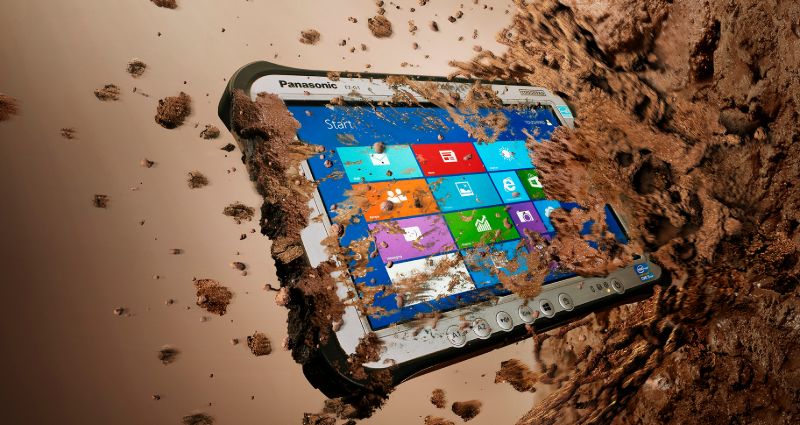
Customers often ask us if a rugged tablet is worth the extra expense compared to a consumer tablet with a protective case. It’s a fair question. What they don’t realise is rugged means far more than surviving a drop. It’s about working in the toughest of environments that require more than a rugged case.
What Makes a Tablet Rugged?
To be classified as rugged, a tablet must meet the Military Standard 810G rating (MIL-STD-810G). The standard requires the tablet pass tests for drop durability, high and low temperatures, humidity, vibration and shock resistance, and more. A series of 28 tests were developed in 1962 so manufacturers could reassure the US military that their equipment could withstand the tough environmental conditions. The tests have been revised over the years with the most recent, Revision G, launched in 2008.
Why Rugged Tablets Cost More Than Tough Cases
You might think it’s the heavy duty looking case that makes a tough tablet, but many of the components are different to those you find in a consumer tablet. These components work together to provide the overall ruggedness needed to pass the MIL-STD-810G rating.
They also have to pass IP standards, which stands for Ingress Protection. Drip, rain and blowing rain tests ensure the device can withstand water at least 10 degrees Celsius cooler than the device. IP standards are developed by the International Electrotechnical Commission, they are not a part of the MIL-STD-810G standards.
Some of the IP tests needed for a tablet to work in the Australian environment include:
Temperature Tests – Our summers can see temperatures hit the high 40s in some places. A consumer tablet isn’t designed to withstand this heat and will probably fail. While freezing cold temperatures aren’t as much of a concern in Australia, sometimes workers are out in the field in cold, wet conditions.
Dust & Sand – Many worksites deal with heavy dust and sand in the air and even with a protective case, the dust can get inside a consumer tablet. Blowing dust and sand ingress tests ensure tiny particles can’t penetrate any side of rugged device in wind conditions similar to standing near an aircraft for hours.
Humidity – A rugged device needs to withstand warm, humid air while in transit and storage for days and extreme temperature and humidity levels that can change fast.
Water – For consumer tablets, being splashed or immersed in water will often spell death but a rugged tablet can cope with both. Immersion or partial immersion (if the device floats) in water is tested with any panels or covers on the device opened and closed under water.
Vibration – Devices are often subject to vibration and many consumer tablets have had the screen crack or stop working while travelling in a vehicle on a corrugated road. No protective case can stop the effects of vibration. Laboratory shaking tests that vary the vibrations’ wave form, frequency and intensity simulate the rugged tablet being on a car or carried by a person. The tests ensure the device can withstand vibrations at different points of its lifecycle.
Shock – Many consumer tablets are destroyed to dropping. Any tablet can be dropped, knocked or fall out of vehicles and off tables and chairs. Even with a protective case, the shock causes a component to fail or the screen to crack. A rugged tablet withstands being dropped multiple times from various heights on to different surfaces. During testing, the device is inspected after each drop for damage and to check it still works.
Rugged Tablets Are Designed for Hard Work Outdoors
As well as being able to withstand knocks, drops, extreme temperatures and conditions, a rugged tablet needs to cope with various light conditions.
Consumer tablets are designed for ideal light conditions indoors but once you move out into the field in bright sunlight, they don’t work so well. The user can squint and move the tablet in all different angles but they’ll struggle to read the screen. Rugged tablets have screens designed for any light conditions including the bright midday sun.
Consumer tablets might cope with kids’ sticky fingers but a rugged touch pad needs to work when the user is wearing gloves made from a range of thin and thick materials.
Commercial tablets also need to work much harder than consumer tablets. They design them for constant use during a 12 hour shift and most support replaceable batteries so workers can keep going even when they aren’t near a power supply.
With a rugged tablet you are paying for far more than the tough case it’s housed in. It’s the screen, the casing, the componentry and thorough testing that make rugged tablets so tough.
If you want to know which rugged tablet is best for your work environment, don’t hesitate to ask one of the experts at Roaming Tech by calling 1300 131 933 or contact us online.